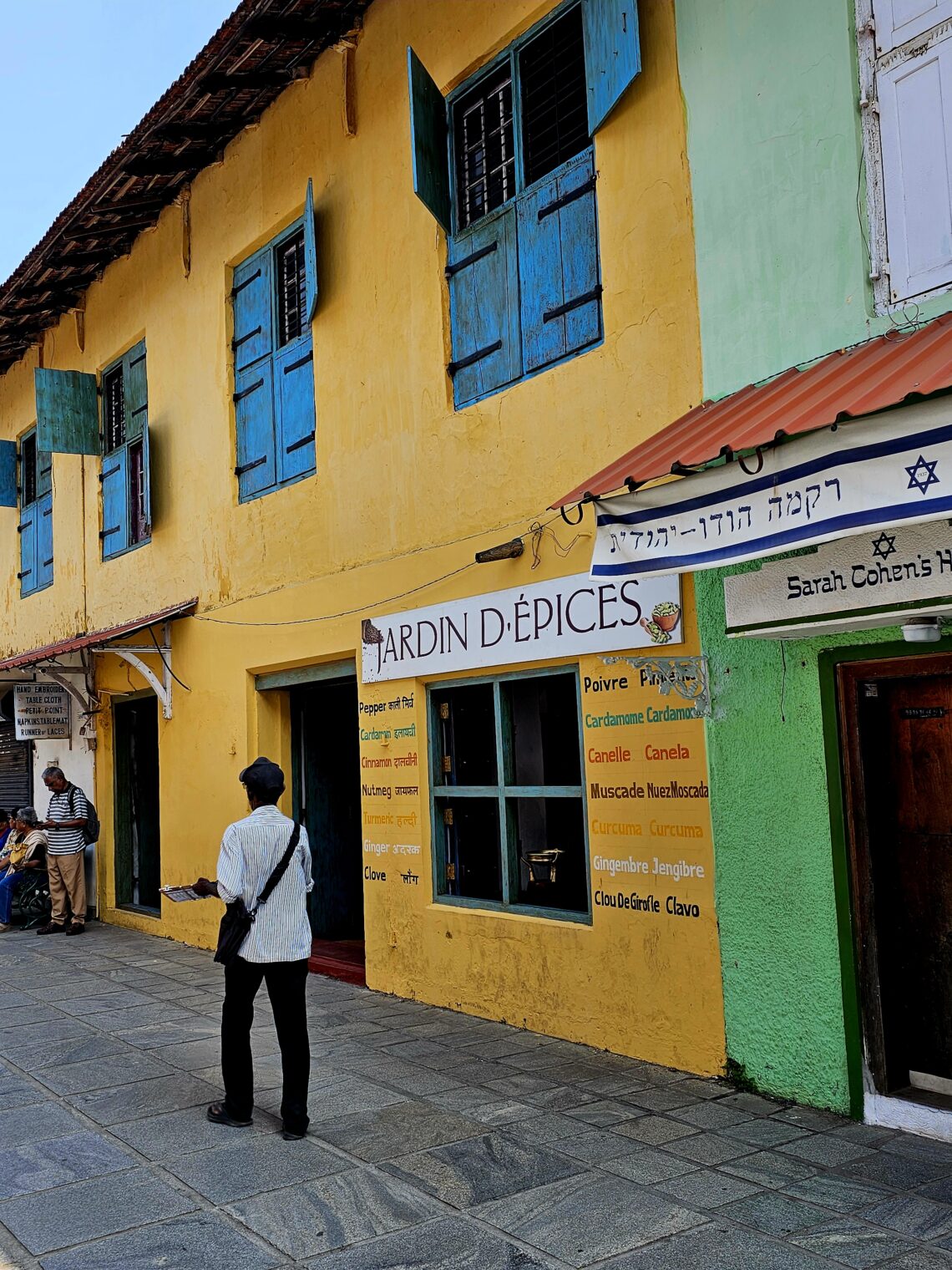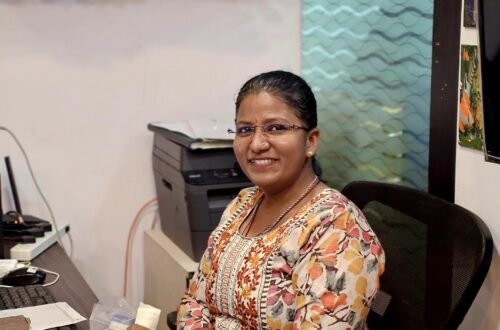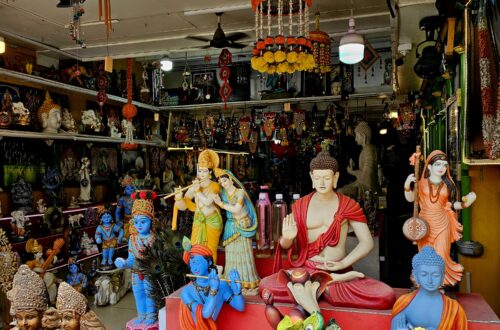
The Queen of The Arabian Sea ( Kathy -Fort Kochi – Feb. 24)
Check Instagram. Reel about Fort Kochi.
Version en français plus bas.
My memory loves to play tricks on me.
Some years back, I embarked on a journey aboard the Netravati Express from Mumbai to Ernakulam*. A captivating 22-hour journey, provided everything went smoothly. Upon reaching the station, a strong desire to stretch my legs overcame me, leading me on foot to the Boat Jetty. There, I aimed to catch a ferry bound for Fort Kochi*, a destination awaiting my exploration for the very first time.
My attention was immediately captured by an unusual sight—servers adorned in turbans at the Indian Coffee Houses. Right across the jetty, a little gem of an ICH awaited. Oddly enough, in my memory, it was a rather humble spot. Was I in a bit of a haze after that lengthy train journey?
Yesterday, upon my return, I discovered an absolute treasure. The structure housing it was quintessential and undeniably charming. The room was lively, packed to capacity, service seamless, the menu classically curated, and the atmosphere, delightful!
Concluding my rounds of the Indian Coffee Houses with this particular wonder brought forth a flood of cherished memories. Although I still have pending articles about those in Thrissur and Guruvayur, I’ve entered the thirteenth and final week of my journey, leaving no time for further explorations this time, I guess.
Taking advantage of the opportunity, I treated myself to two days in a place oozing charm: Fort Kochi!
Fort Kochi offers a captivating journey through Indian and international history. Its narrative is crafted by the influences of diverse civilizations, resulting in a tapestry of unique cultural experiences.
In the 16th century, the Portuguese established a commercial foothold in the area. The Dutch, succeeding the Portuguese, fortified the region, contributing significantly to the thriving spice trade. Subsequently, in the 18th century, the English took charge, integrating Fort Kochi* into the British Raj. Strolling through Kochi or in the vicinity of the Fishing Nets, introduced by Chinese merchants in the 14th century, the homes are named, each echoing a different chapter of Fort Kochi’s history. The Dutch Palace, The Jewish Synagogue, Vasco de Gama Square…
Yet, Fort Kochi was not merely a hub of commerce; it was a vibrant space for cultural exchange. Travelers from across the globe left their mark, creating the kind of diverse blend that I truly relish!
A distinctive feature is Jew Town, a neighbourhood where a thriving Jewish community has existed since ancient times. The Paradesi Synagogue, dating back to 1568, stands as a testament to this rich history. Every visit to this enchanting quarter elicits a sense of wonder.
Fort Kochi also holds the distinction of being the first place in India to raise the flag of independent India in 1947, symbolizing the end of colonial dominance. This creates a poignant connection with the inception of the Indian Coffee Houses, born in the post-independence era, fueled by the idealism of cooperation. These establishments also played a crucial role as centres for intellectual and political discourse.
Today, the city retains its allure with colonial-era structures, iconic Chinese fishing nets, contemporary art galleries, and vibrant street art. The smooth integration of the ancient and the modern is palpable, accentuated by events such as the Kochi-Muziris Biennale, elevating the city on the global art stage.
Fort Kochi transcends the typical tourist destination. It’s a plunge into another ever-evolving India.
- Kochi (Cochin), a port city, is part of the district of Ernakulam. When the locals refer to Ernakulam they’re referring to the mainland portion of the Kochi city. Fort Kochi refers to the traditional city zone in the peninsular portion, across the harbour.

Ma mémoire me joue des tours.
Il y a quelques années, j’avais voyagé à bord du Netravati Express de Mumbai à Ernakulam*. C’est un voyage captivant d’environ 22 heures quand tout roule bien. Arrivée à destination, j’avais envie de me détendre les jambes et me suis rendue à pied au Boat Jetty pour prendre le Ferry qui me mènerait à Fort Kochi* que j’allais découvrir pour la première fois.
Mon regard fut happé par de drôles de tenues! C’était la découverte des serveurs enturbannés des Indian Coffee Houses. En face de l’embarcadère, il y a une perle de ICH. C’est rigolo car dans mon souvenir, c’était un boui-boui! Etais-je en compote à ce point après ce long trajet en train?
En m’y rendant hier, j’ai découvert une petite merveille. La maison qui l’abrite est typique et vraiment charmante. La salle est aérée, pleine à craquer, le service est fluide, le menu est classique et les vibrations sont bonnes!
Je termine mes visites des Indian Coffee Houses avec ce joyau qui me rappelle plein de bons souvenirs. Il me reste encore des articles à publier à propos de ceux de Thrissur et Guruvayur mais j’ai entamé la treizième et dernière semaine de mon périple et n’aurai plus le temps d’en découvrir d’autres cette fois-ci, je pense.
J’en ai profité pour me gâter et passer deux jours dans un lieu bourré de charme: Fort Kochi!
Fort Kochi offre une plongée fascinante dans l’histoire indienne et internationale. Son passé est façonné par l’influence de diverses civilisations, créant une mosaïque culturelle unique.
Au tournant du XVIe siècle, les Portugais y établirent un comptoir commercial. Les Néerlandais, succédant aux Portugais, renforcèrent les fortifications, contribuant à la prospérité du commerce des épices. Puis, au XVIIIe siècle, les Anglais prirent le relais, intégrant Fort Kochi au Raj britannique. Quand tu te promènes dans Kochi* ou dans le quartier des Chinese Fishernets qui ont été introduits par des commerçants chinois au XIVe siècle, les demeures portent des noms qui racontent les différentes étapes du passé de Fort Kochi. The Dutch Palace, The Jewish Synagogue, Vasco de Gama Square….
Cependant, ce n’était pas seulement un centre commercial, mais aussi un lieu d’échanges culturels. Des voyageurs du monde entier y ont laissé leur empreinte. C’est le genre de mélange que j’adore!
Un aspect singulier est le Quartier Juif, où une communauté juive a prospéré depuis l’Antiquité. La vieille synagogue de Paradesi, érigée en 1568, témoigne de cette riche histoire. Me balader dans ce coin me fait craquer à chaque visite.
Fort Kochi fut également le premier endroit en Inde à arborer le drapeau de l’Inde indépendante en 1947, marquant la fin de la domination coloniale. Cela crée un lien plein de sens avec la création des Indian Coffee Houses nés dans le contexte post-indépendance, portés par l’idéalisme coopératif de l’époque, et ayant également joué un rôle important en tant que lieux de rencontre intellectuelle et politique.
Aujourd’hui, la ville conserve son charme avec ses bâtiments coloniaux, ses filets de pêche chinois iconiques, ses galeries d’art contemporain et son street art. L’intégration de l’ancien et du moderne est palpable, renforcée entre autres, par des événements comme la Biennale de Kochi-Muziris, qui a placé la ville sur la carte mondiale de l’art.
Fort Kochi est bien plus qu’une destination touristique. C’est une plongée dans une autre Inde en constante évolution.
- Kochi (Cochin), une ville portuaire, fait partie du district d’Ernakulam. Lorsque les habitants font référence à Ernakulam, ils parlent de la partie continentale de la ville de Kochi. Fort Kochi fait référence à la zone traditionnelle de la ville dans la portion péninsulaire, de l’autre côté du port.






